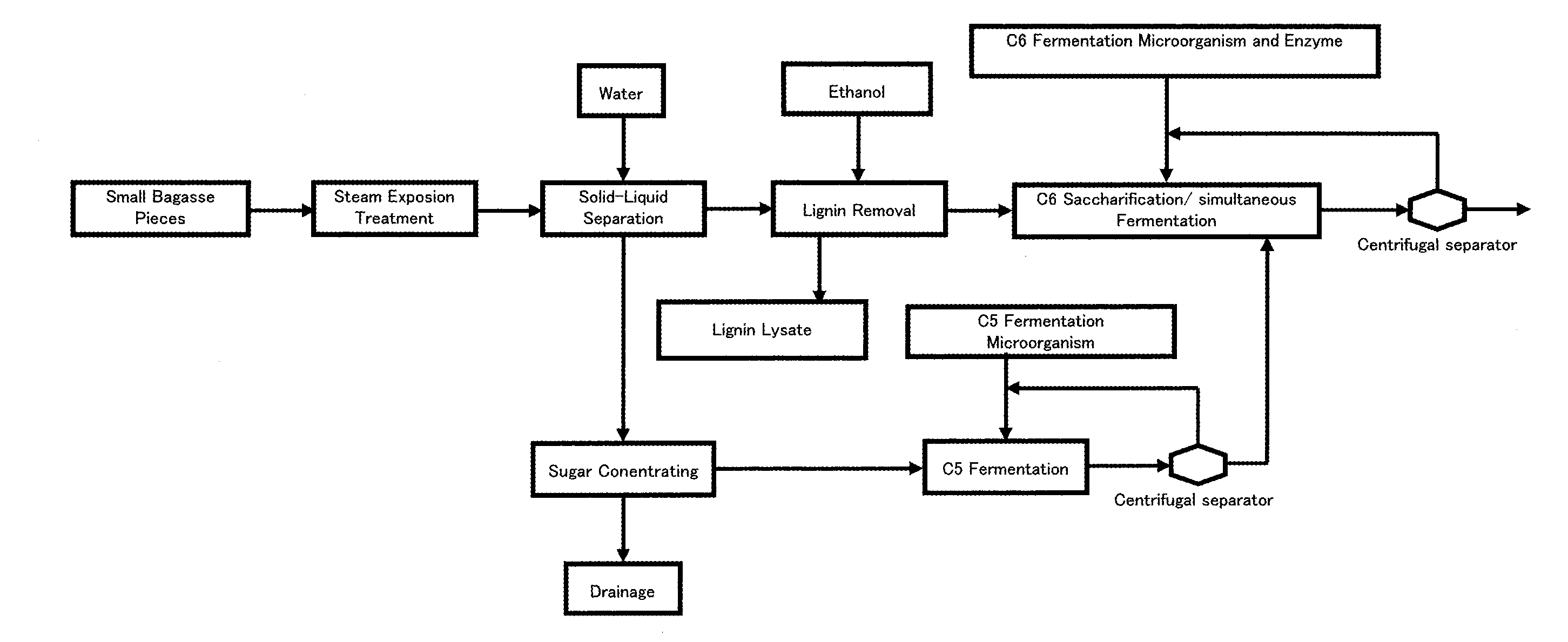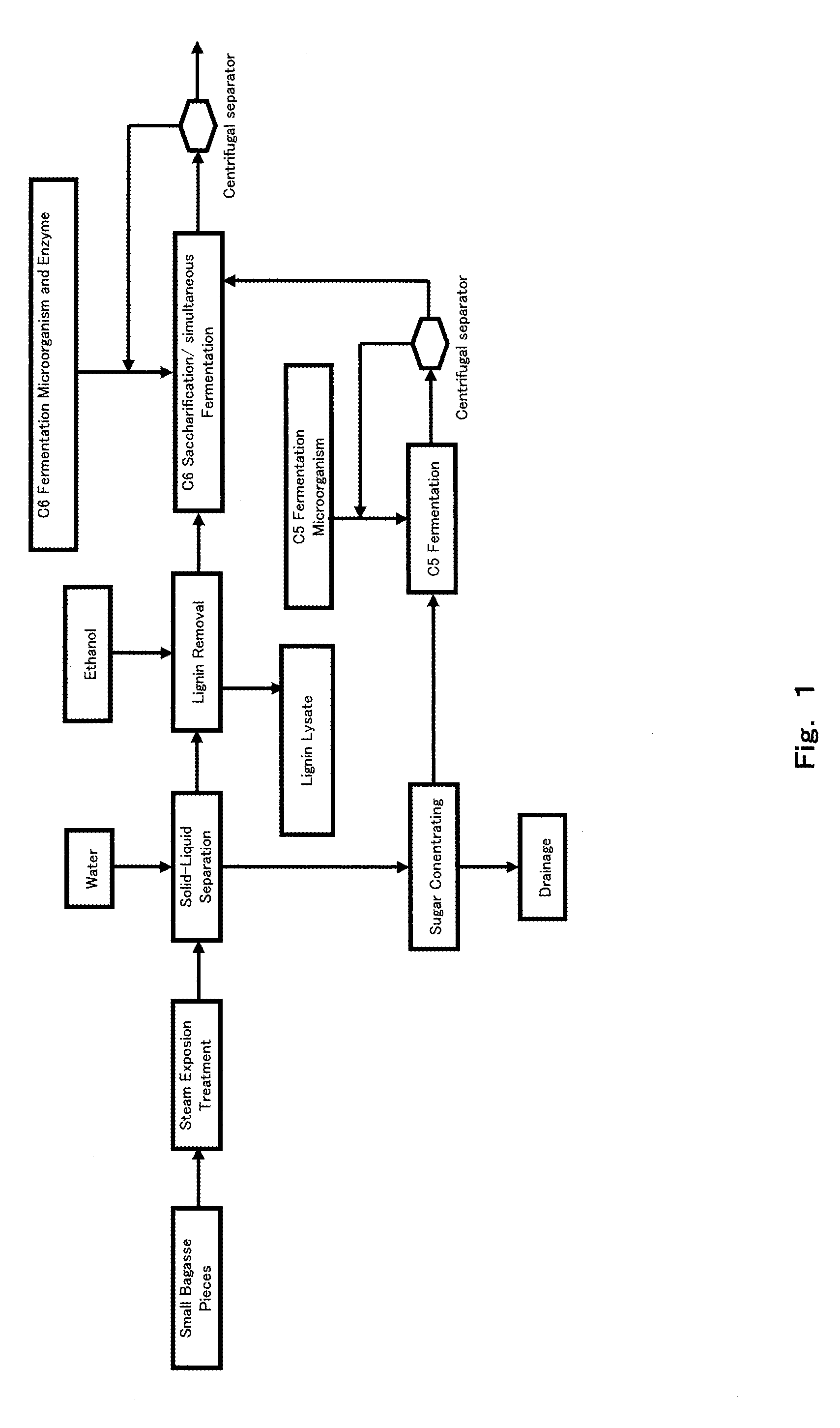Method for producing ethanol from lignocellulosic biomass
- Summary
- Abstract
- Description
- Claims
- Application Information
AI Technical Summary
Benefits of technology
Problems solved by technology
Method used
Image
Examples
embodiment 1
[0045]The process flow chart according to Embodiment 1 of the present invention is shown in FIG. 1.
[0046](Decomposition Step)
[0047]First, lignocellulosic biomass (hereinafter, referred to as “biomass”) such as sugar cane bagasse is broken into small pieces to give a mean diameter of not greater than 30 to 50 mm (preferably, not greater than 10 mm) with a crushing machine or a grinding machine, etc. Hemicellulose component in the biomass is saccharified by subjecting these small pieces to a steam explosion treatment using steam in a steam explosion device (200 to 240° C., 1.5 to 4 MPa, 1 to 15 minutes; preferably, 225 to 230° C., 2.5 to 3 MPa, 1 to 5 minutes).
[0048]The biomass treated by the steam explosion device (steam-exploded material) includes C5 saccharified solution derived from hemicellulose, fermentation inhibitors such as decomposed sugar components and lignin lysate, and solid residues. The steam-exploded materials are separated into steam-exploded solution and a solid res...
embodiment 2
[0076]While biomass such as sugar cane bagasse small pieces is subjected to a steam explosion treatment with a steam explosion device in Embodiment 1, the steam explosion device can be replaced by a subcritical (water) device. For example, as shown in FIG. 3, in place of subjecting the bagasse small pieces to the steam explosion treatment, applying a sudden decrease in pressure by a flash unit after the small bagasse pieces were treated with hydrolysis at a subcritical state can achieve similar effects.
[0077]It is preferable to use the subcritical (water) device at a subcritical water temperature of 160 to 240° C. with the treatment time period of 1 to 90 minutes. The subcritical solvent is not limited to water, and an organic acid such as acetic acid (for example, at concentration of not greater than 0.1 M) or ethanol mixed solution may be used.
[0078]It should be noted that even in the case of using water as the subcritical solvent, performing ethanol immersion or aqueous ammonia i...
embodiment 3
[0079]In Embodiment 1, the biomass as a carbohydrate material was broken into small pieces to give a mean diameter of not greater than 30 to 50 mm (preferably, not greater than 10 mm) with a crushing machine or a grinding machine prior to the saccharification treatment. However, in the case in which the biomass is subjected to a steam explosion treatment under conditions of 25 to 35 atm and 5 minutes or longer, the biomass is ground into a fine powder of not greater than 100 μm; therefore, it is not necessary to give the mean diameter of not greater than 30 to 50 mm as long as the carbohydrate material can be ground into a size easily being handled in the later stage.
PUM
| Property | Measurement | Unit |
|---|---|---|
| Fraction | aaaaa | aaaaa |
| Fraction | aaaaa | aaaaa |
| Fraction | aaaaa | aaaaa |
Abstract
Description
Claims
Application Information
 Login to View More
Login to View More - R&D
- Intellectual Property
- Life Sciences
- Materials
- Tech Scout
- Unparalleled Data Quality
- Higher Quality Content
- 60% Fewer Hallucinations
Browse by: Latest US Patents, China's latest patents, Technical Efficacy Thesaurus, Application Domain, Technology Topic, Popular Technical Reports.
© 2025 PatSnap. All rights reserved.Legal|Privacy policy|Modern Slavery Act Transparency Statement|Sitemap|About US| Contact US: help@patsnap.com



